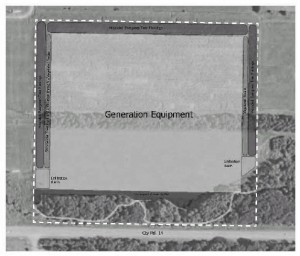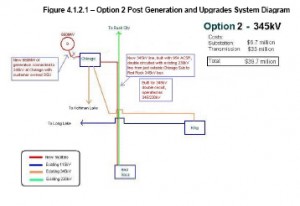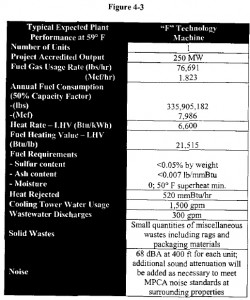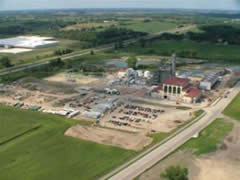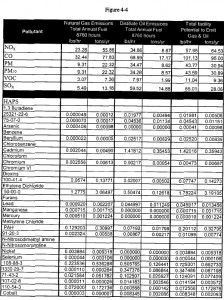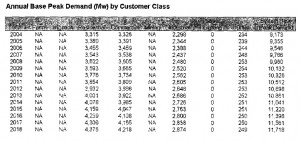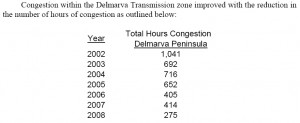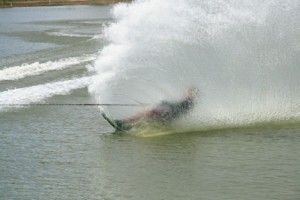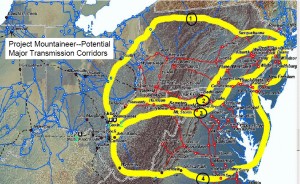500+ give LS Power a piece of their mind
October 20th, 2009
XCEL DOESN’T NEED OR WANT MORE ELECTRICITY, XCEL DOESN’T WANT A POWER PURCHASE AGREEMENT WITH LS POWER, SUNRISE ENERGY, OR WHOEVER…
That was the most important thing to come out of last night’s meeting. Mikey Bull was clear, stating in a most Norwegian way that “despite what Carol thinks, our load is growing,” and that they “won’t have a need… until 2016 or 2017.” I hope that people LISTENED CAREFULLY and were thinking critically.
Shellene Johnson, CRVC, walked Bob Cupit through the siting review and permitting options:
Bob was thrilled, I’m sure, he thought I’d put her up to it, but hey, I’m innocent — this is info that needs to be public, so that people understand all the options. Shellene had questions, particularly where this was an issue that had come up way back when we worked on the County Essential Services ordinance, and wanted to beef up the county’s ordinance to give them some options if a project went through local review. Local review is NOT a new issue for Chisago County, and if you recall, the SE Metro line went through the local review process.
Alan Muller was his usual delightful self, leading Blake Wheatley through a list of questions that demonstrated the “vaporware” nature of this project — he couldn’t or wouldn’t give us any information at all about the project. He knew NOTINK!
What would be the output of this plant? Answer:
780 MW summer rating. Over 800 winter rating. [Gas turbines
make more power when the air is colder and more dense.]How many generating units would there
be?
Answer: Don’t
know/haven’t decided.Who would be the manufacturer of the combustion
turbines? Answer:
Don’t know/haven’t decided.Who would be the manufacturer of the steam
turbines? Answer: Don’t
know/haven’t decided.How many smokestacks would the plant have?
Answer: Don’t know/haven’t
decided.How gallons or barrels of oil would be stored on the
site:
Answer: Don’t know/haven’t decided.How much oil would be burned in a
year?
Answer: Don’t
know/haven’t decided.In your air permit application, how many pounds per year of regulated air
pollutants would you be asking permission to put up your
smokestacks? Answer: Don’t know/haven’t
decided.And so on …..
…he knew nothing at all about this, and that’s because there’s nothing to know. There’s no project plan, no Power Purchase Agreement, no state permit applications, nada… This isn’t a project, it’s a farce… Tom Micheletti could take lessons from Blake Wheatley. Here’s the site plan, from the Oct 15 2009 Revised Draft Development Agreement:
WOW, that says a lot…
Take the time to read these:
Oct 15 2009 Revised Draft Development Agreement
I promised to post a few things so people can learn about prior proposals to get an idea what this one means, so let’s do that. Bear with me, this is interesting stuff!
This MISO Interconnection study says that for 660MW of generation at the Chisago sub, lots of transmission would need to be added. Here’s what one of the two similar options looks like (it’s better in print than here, looks hard to read):
Next is an answer to “what exactly are they proposing” with a couple of prior applications for gas plants as examples of what to expect, what to look for:
Faribault Energy Park – Application
These two applications are important to see what gas plants are all about. For example, the Faribault Energy Park is a 250MW plant, and here are some fun facts from the application:
A 250MW plant is 68 dB(A) 400 feet from the plant… what will a plant three+ times that be?
Here’s what that plant looks like – REMEMBER 750MW IS THREE TIMES THE SIZE OF A 250MW PLANT AND 855MW IS NEARLY FOUR TIMES AS LARGE:
Here’s a closer side view:
Here’s an emissions chart, and remember, the LS Power proposal is 3+ times this, so expect over three times the emissions:
And here’s a fun fact, from the 2004 Blue Lake application, showing their projected “need” back in 2004 that’s WAY overestimated:
From Xcel’s 2008 10-k, p. 10:
Capacity and Demand
Uninterrupted system peak demand for the NSP System’s electric utility for each of the last three years and the forecast for 2009, assuming normal weather, is listed below.System Peak Demand (in MW)
2006 2007 2008 2009 Forecast
9,859 9,427 8,697 9,662The peak demand for the NSP System typically occurs in the summer. The 2008 system peak demand for the NSP System occurred on July 29, 2008.
And now we know that instead of inexplicably going up in 2009, it’s going down. DOWN, further down. But note that in their 2008 10-k, Xcel admits that system peak was 8.697, lower than 2004. That pushes out any need until when? And the longer this drop continues, the further out and less probably any increased need is! And remember, Blue Lake was added to address the 11,000MW need claimed in the application. To get beyond that, how long will it take? With conservation, probably forever, we’ll never need more!
So, folks, as you can see, this isn’t rocket science, and they have no plan, no Power Purchase Agreement, it isn’t needed, it isn’t wanted. LS Power, go away.
So another utility toady thinks I’ve got my head implanted…
October 4th, 2009
.
Apparently Jonathan Travers, “Engineer of Knowledge” is another utility toady or self-declared energy wonk, and thinks I’ve got my head implanted regarding my comments about the MAPP line and about PSE&G’s dissing Midwest transmission. EH? I’d say my Google Analyics stats say otherwise. And then there’s the little energy birdie who admitted the other day that Legalectric is one of his first stops in the morning!
Who is Jonathan Travers? Haven’t a clue, his reputation does not exceed him! Google’s got very little to say. Hmmmmmmm… There is a “Travers” on the Dorchester County Council, Ricky Travers. This “Jonathan Travers,” he’s got a blog, Jonathan Travers Chronicles, with only a handful of postings that are focused on blasting opposition to the Mid-Atlantic Power Pathway (MAPP) transmission line, i.e., Dorchester County’s Dorchester Citizens for Safe Energy and Eastern Shore Land Conservancy, who are having some success in fighting the MAPP line, and though Travers’ blog’s banner states “Debate Through Logical Argumentation Only. Not For Flamers!” the level of discourse he’s posting is not even up to “Horse’s Ass Awards” and such:
Here are his comments about my MAPP post, “MAPP Transmission Line Under the Microscope” a couple weeks ago:
Submitted on 2009/10/04 at 9:18amTo the attention of Legalectric Blog.
You make the statement, “this transmission line is not needed.” Per logical argumentation, you make (sic) no backup facts to support this opening statement. As any English writing course teaches, this is just poor writing skills (sic). As it has been (sic) well documented by “The Public Service Commission” report (sic) released last December (sic) warned that the state could experience rolling blackouts as early as 2011 to helped (sic… really!) people understand the reason for MAPP’s conception. So with just your opening statement, you have negated your argument and quite poorly I might add (how “sic” can it be?).
Overland comments: “backup facts” about transmission line not needed can be found by searching this site for “decreased demand” and “PJM annual report” and PJM Load Capability. Ummmm, Hello, I’m a writing major, and your comment about “poor writing skills” isn’t about writing, it’s about evidence that you want. Don’t worry, it’s there, just look! “Rolling blackouts” is hysteria, blown away by DEC’s annual Energy Plan, showing sharply decreased congestion on the Delmarva peninsula:
You then go on to post the article from the Star Democrat written by Dustin Holt who may have a journalistic degree but by his statements he has no knowledge of electrical engineering. I have spoken with Mr. Holt in the past and within a short amount of conversation, it was quite apparent that he did not even have the basic understanding of what he was writing about. Mr. Holt starts off by referencing statements from Libby Nagel who has self proclaimed herself (sic) president of the Dorchester Citizens for Safe Energy. It is my evaluation that with her lack of electrical engineering knowledge, Ms. Nagel would be better off proclaiming herself President of the Dorchester’s chapter of the Mickey Mouse Club (SIC!). So once again you have quoted a source that does not have adequate credential (sic) to even be speaking on the subject negating your argument again.Overland comments: I posted the article as a good example of on-the-ground activism, where people work to increase awareness of their issue, and Dorchester Citizens for Safe Energy did a great job! They got press coverage, their elected officials showed up, and pro-MAPP people are flailing wildly — that’s a measure of success! Libby IS, not was, the President, and IS self-DESCRIBED President, she was elected President by the organization, it’s “described’ not “proclaimed.” Your “evaluation” is really immaterial. Ms. Nagel has all the “credential” necessary to speak as an affected community member and President of the primary opposition organization. The article I posted says she’s the “Chairman,” and not “President.” Really!
Let me try to explain it this way. If you run just one transmission route like Ms. Nagel is stating would be (sic) like having one extension cord with a hundred electrical appliances, tools, etc. plugged into it. It will not be long before you have overloaded the circuit causing a short circuit or even causing a fire. It is the diversification that the multiple routes provide so that the electrical load required by the Delmarva Peninsula (sic) is what makes the electrical grid secure and stable.
Overland comments: This is such convoluted and tortured writing that it’s hard to tell where to put the “sic” parentheticals in. WHEW! Anyway, back to “substance.” WTF? I see only one reference to Ms. Nagel in the article, “Dorchester Citizens for Safe Energy Chairman Libby Nagel said the power line would require about a 200-foot right-of-way.” Nowhere in this article is Nagel advocating for “just one transmission route,” and I don’t think Nagle advocates for ANY transmission route, she’s stating that a new transmission line is not needed!
I would suggest that your readers can get the correct and accurate arguments with regards to MAPP at my site http://www.jonathantraverschronicles.blogspot.com/
Overland comment: I would suggest that my readers check out the site and comment away!!! Have at it. My readers will be able to easily dissect that site.
Good day,
Jonathan Travers
Oh, he’s not THAT Jon Travers???
OK, now on to his next comment, on the “PSEG’s Izzo disses Midwest Transmission” post :
Submitted on 2009/10/04 at 2:54pmTo the attention of Legalectric Blog.
In your earlier posting you made the statement, “PJM, the private utility transmission promotion entity, has admitted that the Indian River to Salem part of the line is not justified, and have taken it off their wish list.”
Counter Point:
To start off with PJM simply stands for Pennsylvania, New Jersey, and Maryland and the state of Delaware has now (sic?) been included since its conception. PJM is an oversight committee (EH?) made up of knowledgeable people in the industry but they do not tell power utilities to build anything (EH?). It is the utilities (sic) to come up with their own plan to address the problem of the soon (sic) lack of electrical power for their regions. Again your statement you are passing on are (sic) incorrect(sic) negating you (sic) argument.Overland comment: PJM is more than a committee, it’s a formal business organization. PJM IS the utilities, and per PSE&G testimony in the Susquehanna-Roseland case, PJM is telling them to build the line. Now obviously PJM has no authority, but if they press the matter with FERC, FERC could direct the utilities to build it. It’s much more than an “oversight” committee, it’s an organization that is comprised of utilities, and they not only address electric reliability issues, but they control and manipulate the electric market. “Lack of electrical power?” Somebody hasn’t been reading the SEC filings, reserve margins, and annual reports, EARTH TO MARS, there’s a substantial decrease in electrical use and need, we aren’t going to have a power shortage. Project Mountaineer is not a plan of the individual utilities’ making. JCSP is not a plan of individual utilities, CapX is not a plan of individual utilities…
“A little knowledge is a very dangerous thing,” and the writer of this blog has demonstrated their sever (sic) lack of knowledge in this subject by the statements presented.”
Overland comment: Oh, uh-huh…
Now with this posting they are stating their case as if there is only one transmission line that needs to be considered. For those educated in electrical engineering, it is plain that the writer of this blog does not even have the basic understanding of Ohms Law. What MAPP is offering are multiple access points for electrical transmission routes.
Overland comment: Ummmmm, “they?” And who is advocating for transmission? This is the same thing that “Travers” says about Nagel, who said nothing of the sort. This mantra does not fly. Multiple access points? For what generation? Let’s get clear about that…
For anyone else whom (sic) should (sic) like to inform themselves more proficiently on this subject, I suggest you go to http://www.jonathantraverschronicles.blogspot.com/ where this has all been address (sic) before.
Thank you,
Jonathan Travers************************************
Overland comment: Whoever wrote this is clearly not a native speaker/writer nor in any position to critique writing. Content, well, anyone can criticize content, but I’d guess that “Travers” is a retired engineer or a newly imported engineer who has not had experience with the capitalist system and the shift of focus of PJM, MISO, etc., to economic dispatch, a market system, where economic considerations are primary, and where the game in transmission is how to build out as much as possible while shifting cost-allocation elsewhere, for someone else to pay, anyone. Then PJM gets shot down by the 7th Circuit and all their transmission cost apportionment plans are in limbo.
PSEG’s Izzo disses Midwest Transmission
September 30th, 2009
Did I hear that right???
I’m fighting with PSEG out in New Jersey, representing Stop the Lines on the Susquehanna Roseland transmission line. PSEG can be vile… but on this one point, PSEG’s Ralph Izzo is right. Now, if we can just get him to be consistent.
Transmission is not rocket science, and Izzo statements reflect that he understands what Midwest transmission is all about — $$$ and coal. He and PSEG have joined the many who are standing up to Midwest transmission plans. Now, is the Midwest paying attention? As PUC Chair Boyd said at the last Legislative Energy Commission meeting, they need a solid business plan. Guess what — they don’t have one, DUH!!!! There’s no market (Doesn’t Chair Boyd or anyone else in the room think there’s something a little too cozy about Boyd advocating for transmission with MISO???).
Today at a conference, PSEG’s Izzo let loose and let them have it:
Here’s some propaganda from PSEG:
In short:
Now just who does this sound like?!?!?!?! Hilarious… dig this, though he’s not admitting the INTENTIONALITY of the transmission scam:
And this broad view so contradicts their Susquehanna-Roseland transmission plan, which is all about coal from Amos = it’s the NE part of “Line 1” in Project Mountaineer. PSEG, you can’t have it both ways! Let us hope that now that he’s spouting opposition to the Great Midwestern Transmission Scam he’ll see the scam of New Jersey transmission. At least we’ll now have this to use. THANK YOU, RALPH IZZO!
MAPP transmission line under the microscope
September 26th, 2009
Before we get started, a note about need. As usual, this transmission line is not needed. PEPCO’s Mid-Atlantic Power Pathway, or MAPP line, not to be confused with Mid-Continent Area Power Pool (MAPP), is the red line on the map above. PJM, the private utility transmission promotion entity, has admitted that the Indian River to Salem part of the line is not justified, and have taken it off their wish list. Now, about the rest of it…
And where did MAPP come from? It’s part of Project Mountaineer, which is planned to bring cheap coal generation from the Amos plant and others, like the coal plant planned by Delaware Electric Co-op. Without this transmission line, the coal generation would not be used in the Mid-Atlantic or parts further NE, i.e., New York.
The MAPP transmission line had a day of scrutiny last week when MAPP opposition groups hosted a tour and luncheon featuring former Maryland Gov. Harry Hughes speaking against the line. State Senators and staff from both Maryland U.S. Senators were present, and it looks like they got an earful and eyeful! They used balloons to show the height of the lines, as we did in Susquehanna-Roseland last month, and Chisago years ago.
Here’s the full story:
Tour focuses on MAPP problems
By DUSTIN HOLT Special from The Star DemocratPublished: Friday, September 25, 2009 9:56 AM CDT
The Eastern Shore Land Conservancy and the Dorchester Citizens for Safe Energy along with the Dorchester County Tourism Department organized a tour through Dorchester County last week to show the impact the proposed Mid-Atlantic Power Pathway project would have on the county’s heritage, agriculture and wildlife.
Pepco Holdings is proposing a 27-mile high-voltage electrici transmission line crossing Dorchester County as part of the MAPP project, from Taylor’s Island to Vienna.
The ESLC suggests the towers would be 150 feet tall, though Pepco puts them between 110 and 130 feet. According to the ESLC, the towers would consume 650 acres of county agriculture, forest and rural lands.
The Sept. 16 tour included lunch at the E.A. Murphy Community Center in Vienna, with former Maryland Gov. Harry Hughes as a guest speaker.
“Many of us are opposed to it (the MAPP Project) because insufficient studies have been done for this line,” said Hughes, an advisory committee member of the ESLC. “Have they looked at alternatives?”
Hughes said one alternative is to improve the Vienna Power Plant, which is not operating at full power. He said another alternative is to introduce energy conservation standards to reduce the need for the power lines.
“This is a massive project that will disrupt the landscape,” Hughes said.. “There are too many unknowns with no alternatives considered. As far as I can see, there is no need to rush into this.”
Vienna Mayor Russell Brinsfield, one of the founders of ESLC, said MAPP would permanently and negatively impact Vienna. He said alternatives should include the state promoting energy conversation and renewable resources.
State Sen. Richard Colburn, R-37-Mid-Shore; Del. Addie Eckardt, R-37B-Dorchester; and Jeannie Haddaway-Riccio, R-37B-Talbot, were in attendance at the lunch in Vienna.
Eckardt said it is important to preserve the heritage and agriculture in the county, “Our biggest asset is our land, fisheries and agriculture.”
If MAPP project must move forward, Eckardt said, the state needs to look where the project will not be environmentally sensitive nor impair the landscape of the county.
The tour headed from Vienna, through Blackwater National Wildlife Refuge and back to Cambridge.
Dorchester Citizens for Safe Energy Chairman Libby Nagel said the power line would require about a 200-foot right-of-way.
To demonstrate the height of the towers, balloons were deployed to a height of about 150 feet.
Local farmer Lin Spicer said spraying crops would be ineffective with the power lines because planes would not be able to get below the lines. “We would be forced to spray from above the towers and the wind would blow the spray all around before it reached the crops,” he said.
Blackwater Manager Susan Baird said the MAPP towers would have a great impact on wildlife and wetlands. She said bald eagles need a living area of at least five miles. “They won’t fly over the towers, so you can’t tell me they or other birds will not move on to different locations outside of Dorchester County if the power lines are put here,” Baird said.
Maryland rejects PATH transmission line
September 10th, 2009
Potomac Appalachian Transmission Highline
The Washington Post says:
Allen Staggers — Ja, I’ll bet he sure does now!!!
***********************************
Yes, “transmission from hell” is everywhere… here are some sites for opponents of the PATH line:
Pennsylvania Land Trust Association
The Applicants who just got slapped up by Maryland:
And here’s the TOADIES for PATH – dig the logo, compare with PATH:
***************************************
Maryland’s Public Service Commission seems, indeed, to be dedicated to the public! It has rejected the Potomac-Appalachian Transmission Highline, PATH, transmission project application.
The Baltimore Sun gets it:
PSC right to reject power line
In the Frederick News-Post:
Maryland Commission Rejects PATH Transmission Application
Posted Thursday, September 10, 2009
“We see it as a procedural decision based on interpretation of Maryland law,” Colafella said.
Allegheny and AEP will continue to pursue the line in Virginia and West Virginia, he said.

